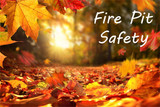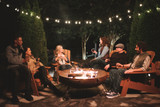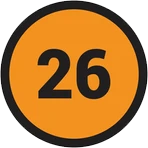Fire Pit Safety Tips Every Homeowner Should Know
There’s something undeniably magical about kicking back in your backyard next to a warm crackling fire. Whether you're roasting marshmallows with friends, sipping wine under the stars, or simply unwinding after a long week, a fire pit transforms an ordinary outdoor space into a cozy retreat. But with that warm glow comes an important responsibility: safety.
Fire pits—whether gas, electric, or wood-burning—can be perfectly safe when used correctly. The problem is that many homeowners don’t realize how quickly things can go wrong. A little wind, a stray spark, a misplaced chair, or even the wrong kind of firewood can turn an evening of relaxation into a not-so-fun story for the insurance company.
So if you're considering adding a fire feature to your backyard (or you already have one), these fire pit safety tips every homeowner should know will help keep your gatherings warm, relaxing, and accident-free.

1. Choose the Right Fire Pit for Your Space
Before you light your first flame, you need the right fire pit. Not all fire pits are created equal—and not every backyard is suited for every style.
When shopping, be sure to choose something durable, high-quality, and safe for long-term use. And if you want to browse options, check out these great selections of Fire pit safety features and models.
If you’re into classic campfire vibes, you might love outdoor fire pits that burn real wood and deliver that unmistakable crackling sound and earthy scent. But if convenience is key, a gas fire pit offers quick ignition and clean burning with fewer sparks.
Whatever you choose, make sure it’s:
-
Made from sturdy materials like steel, cast iron, or stone
-
Designed for outdoor use
-
Appropriate for your yard size
-
Stable and not easily tipped over
A well-chosen fire pit is the first step toward a safe backyard setup.
2. Pick the Perfect Location
Location matters more than you might think. A fire pit needs to sit somewhere far away from anything that can ignite—but close enough that you can comfortably enjoy it.
Here’s what to keep in mind:
Keep it at least 10–20 feet from structures
This includes the house, shed, garage, deck railings, fences, and any other flammable surfaces. Many cities have local requirements, so check your municipal guidelines too.
Place it on a non-flammable surface
Patio pavers, stone, gravel, and concrete are ideal. Grass is not great (it can scorch), and wood decks are risky unless you use a properly rated fire pit pad.
Avoid low-hanging branches
Sparks can fly higher than you expect. Keep the overhead area clear—no trees, canopies, pergolas, power lines, or fabric awnings.
Think about wind direction
Wind can send embers into your neighbor’s yard or your own landscaping. Choose a spot with natural wind protection or use a spark screen to keep things contained.
3. Always Use the Right Materials in Your Fire Pit
Now let’s talk fuel. This is where a lot of homeowners accidentally break the rules without realizing it.
Use only dry, seasoned firewood
Wet or green wood creates excessive smoke and can lead to creosote buildup.
Never burn:
-
Trash
-
Cardboard
-
Plastic
-
Leaves
-
Treated lumber
-
Construction materials
Aside from being unsafe, burning these releases harmful chemicals into the air.
If you have a gas fire pit, use only the manufacturer-approved stones, lava rocks, or ceramic logs. No substitutions!
4. Create a Safe Seating Area
Sure, everyone wants to sit close to the fire, but comfort shouldn’t come at the cost of safety.
Follow the 3-foot rule
Keep all seating at least three feet from the fire pit. This helps prevent clothing from catching on stray sparks and reduces the chances of someone brushing against a hot surface.
Use chairs that won’t tip easily
Lightweight plastic chairs aren’t ideal. Opt for heavier, stable options like metal or Adirondack-style chairs.
Make paths easy to navigate
Whether guests are grabbing drinks, taking pictures, or helping with s’mores, make sure the area around your fire pit is clear of tripping hazards like toys, garden tools, or uneven stepping stones.
5. Keep a Close Eye on the Kids and Pets
Kids and pets are naturally curious—which can spell danger around an open flame.
Set clear boundaries
Teach children that the fire pit is not a play area and establish a safety perimeter that they should not cross.
Consider a spark screen
This is especially helpful for wood-burning fire pits. It significantly reduces the risk of embers flying toward little hands or curious noses.
Never leave them alone near a lit fire
Even “just a minute” is too long.
For pets, keep leashes handy, especially if you know your dog is the type to chase glowing embers.
6. Light the Fire Safely
Improper ignition is a leading cause of backyard fire mishaps.
Do NOT use gasoline or lighter fluid
These are extremely dangerous and unpredictable. A fire pit is not a grill.
Instead, use:
-
Fire starters
-
Kindling
-
Small pieces of dry wood
For gas fire pits, follow the ignition instructions exactly as written. If you smell gas at any point, shut everything down immediately.
7. Dress Safely Around the Fire
Yes—this is actually a thing. The clothing you wear can make a big difference.
Avoid loose or dangling sleeves
They can catch fire surprisingly fast.
Skip highly flammable fabrics
Nylon, rayon, and thin polyester melt easily and can cause severe burns.
A good rule of thumb: if you’re planning to roast marshmallows, dress like you would for a camping trip—comfortable but safe.
8. Keep Fire-Extinguishing Tools Close By
Even if you're the most responsible fire pit user out there, accidents happen. Always be prepared.
Have at least one of the following within arm’s reach:
-
A bucket of sand
-
A fire extinguisher (Class A for wood fires, Class B/C for gas)
-
A garden hose
-
A metal fire pit lid
The faster you can respond to a flare-up, the better.
9. Mind the Weather Conditions
Weather plays a huge role in fire pit safety.
Avoid using a fire pit on:
-
Windy days (sparks can travel surprisingly far)
-
Extremely dry days (risk of wildfire increases)
-
During burn bans (check your county or city website)
Even a mild breeze can carry embers across your yard, so err on the side of caution.
10. Know How to Properly Extinguish Your Fire
Many homeowners don’t realize they’re extinguishing their fire pit incorrectly. Here’s the right approach:
For wood-burning fire pits:
-
Let the fire burn down naturally.
-
Spread out the ashes so they cool faster.
-
Pour water slowly—not all at once to avoid steam bursts.
-
Stir the ashes and add more water until they’re cool to the touch.
-
Dispose of ashes only after they are completely cold (this can take up to 24 hours).
For gas fire pits:
-
Turn off the gas valve first.
-
Let the fire pit cool before covering it or storing the components.
Simple steps, but incredibly important.
11. Store Fire Pit Accessories Properly
Anything related to your fire pit—tools, covers, fuel—should be stored safely.
Keep:
-
Firewood is dry and away from your home
-
Gas cylinders should be upright and in well-ventilated areas
-
Covers for your fire pit when not in use to prevent moisture buildup
Taking care of your equipment prolongs its life and keeps everything operating safely.
12. Stay Within Local Laws and Guidelines
Every city has its own policies about backyard fires.
Some require permits. Some restrict what time of day you can use a fire pit. Others limit the size or type.
Always check:
-
Local fire codes
-
HOA rules
-
Neighborhood restrictions
Not only does this keep you compliant, but it also ensures you're using your fire pit in the safest possible way.
13. Never Leave a Fire Unattended—Ever
This is the golden rule of fire pit safety.
Even embers that look harmless can reignite when a breeze kicks up. If you’re going inside, calling it a night, or stepping away for more than a minute, extinguish the fire.
A few extra minutes of effort now can prevent major problems later.
14. Educate Everyone Who Uses the Fire Pit
If you’re the only one in your household who knows the safety rules, there’s a problem.
Make sure everyone—including guests—knows:
-
How to behave around the fire
-
Where the safety tools are stored
-
What to do in case of an emergency
A well-informed group means a safer fire pit experience for everyone.
Final Thoughts: Enjoy Your Fire Pit—Responsibly
Fire pits are one of the easiest ways to bring warmth, charm, and relaxation to your outdoor space. When used responsibly, they’re incredibly safe and endlessly enjoyable. By following these fire pit safety tips, choosing the right setup, and keeping a close eye on your surroundings, you’ll create a backyard environment that’s not only inviting but also secure.
Whether you're exploring Fire pit safety options or shopping for sturdy, stylish outdoor fire pits, good choices and good habits go hand in hand.
So go ahead—light up the night, roast a few marshmallows, share stories, and make memories. Just do it the safe way. Your backyard (and your peace of mind) will thank you.
Fire Pit Tips, Product Guides & Outdoor Living Advice
Fire Pit Safety Tips Every Homeowner Should Know
There’s something undeniably magical about kicking back in your backyard next to a warm crackling fi...
Gas vs Wood Fire Pits: Which One Fits Your Lifestyle
If you're thinking about adding a fire pit to your backyard, you’ve probably run into the classic de...
How to Choose the Perfect Fire Pit for Your Outdoor Space
Creating an inviting outdoor living area has never been more popular, especially as homeowners seek...
The Proper Gas and Wood Fire Pit Height - The Best Seating Guide for Comfort
Outdoor fire pits are a beloved focal point for patios, backyards, and gathering spaces. Whether fl...
Safety When Using a Fire Pit on a Wood Deck
Can You Safely Use a Fire Pit on a Wood Deck? Fire pits are a popular addition to outdoor living sp...
Top Fire Pit Trends for 2025
There’s nothing quite like gathering around a fire pit with friends and family, roasting marshmallow...








